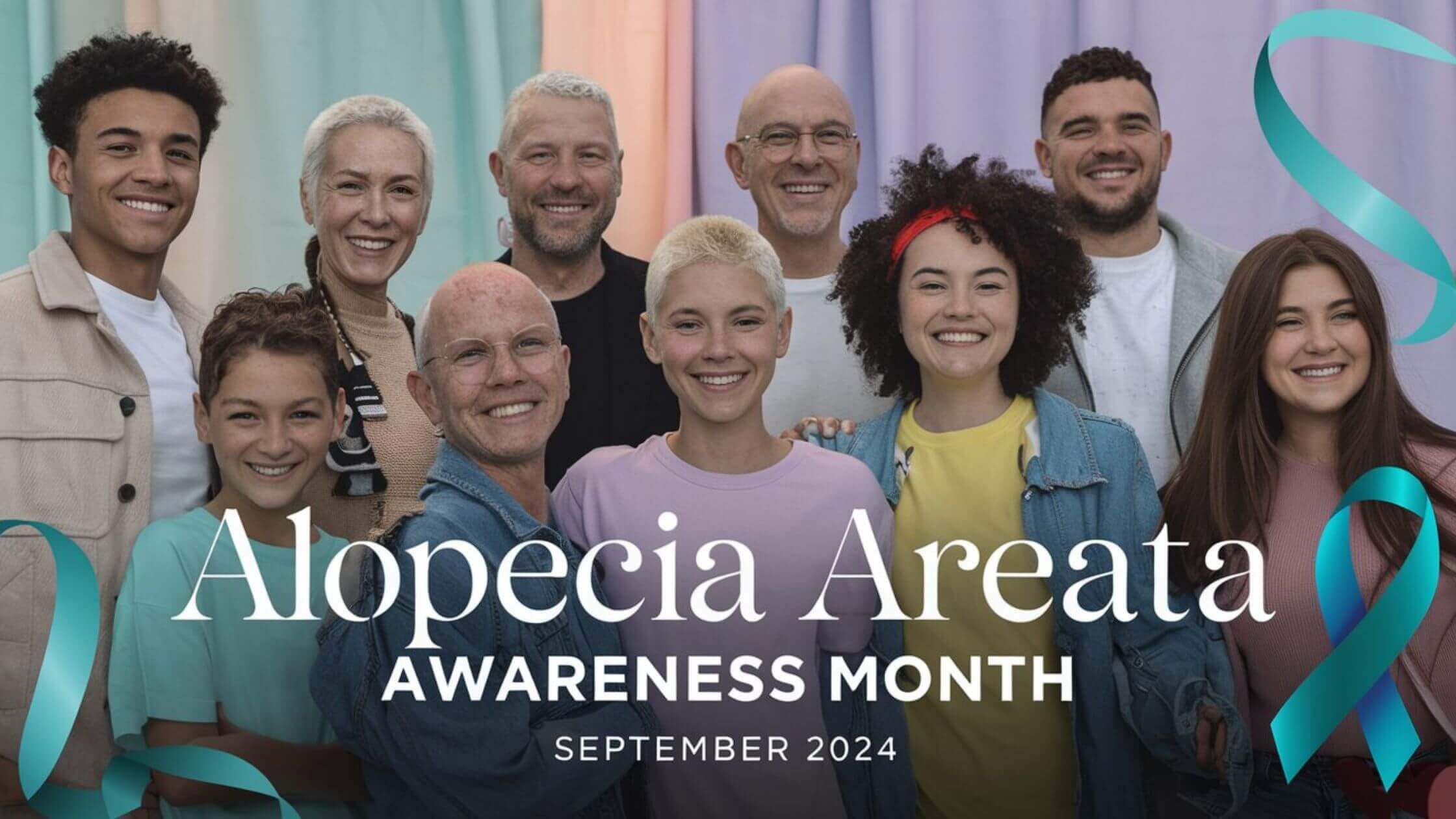Top 23 Alopecia Areata Diet Foods That Grow My Hair...
Read MoreBeyond the Bald Spot: Alopecia Areata Awareness Month

Hair loss can be a difficult experience, but it’s important to remember that you’re not alone. September is Alopecia Areata Awareness Month. This month is dedicated to raising awareness about the disease and providing support to those affected by it.
Let’s explore the different types of Alopecia Areata, its symptoms, and available treatment options. We’ll also discuss how to offer comfort and support to loved ones who are facing this challenge. Together, we can spread awareness, foster understanding, and create a more supportive environment for individuals with Alopecia Areata.
What is Alopecia Areata?
Alopecia Areata is an autoimmune disease that causes hair loss. It occurs when the body’s immune system mistakenly attacks hair follicles. This can lead to patches of hair loss on the scalp, as well as other areas of the body such as the eyebrows, eyelashes, and beard.
Alopecia Areata in the USA
- Prevalence: Approximately 7 million people in the US have or will have alopecia areata.
- Current Cases: Around 700,000 individuals in the US are currently experiencing alopecia areata.
- Age of Onset: The average age of onset is between 25 and 36 years old.
- Children: Nearly 10% of patients with alopecia areata develop the condition during childhood.
- Spontaneous Recovery: 34-50% of individuals with patchy hair loss experience spontaneous regrowth within a year.
Why is Alopecia Areata Awareness Month Important?
Alopecia Areata Awareness Month is crucial for several reasons:
- Raising Awareness: It helps increase public understanding of alopecia areata, dispelling myths and misconceptions about the condition.
- Reducing Stigma: It promotes acceptance and support for individuals living with alopecia areata, reducing stigma and discrimination.
- Encouraging Research: It fosters research efforts to develop more effective treatments and potentially a cure for alopecia areata.
- Empowering Individuals: It empowers individuals with alopecia areata to embrace their identity and live fulfilling lives.
Types of Alopecia Areata
- Alopecia areata: The most common type, characterized by round or oval patches of hair loss.
- Alopecia totalis: Complete hair loss on the scalp.
- Alopecia universalis: Complete hair loss on the scalp, eyebrows, eyelashes, and other parts of the body.
Alopecia Areata can also be associated with other autoimmune diseases, such as vitiligo and thyroid disease.
Symptoms of Alopecia Areata
- Patches of hair loss
- Itching or tingling before hair loss
- Nails may become brittle or ridged
Causes of Alopecia Areata
The exact cause of Alopecia Areata is unknown, but it is thought to be related to an overactive immune system.
What are the Treatment Options for Alopecia Areata?
There is no cure for alopecia areata, but there are several treatments available that can help to manage the condition. These include:
- Topical medications: Corticosteroid creams or ointments can help to reduce inflammation and promote hair growth.
- Injected corticosteroids: Corticosteroids can also be injected directly into the affected areas of the scalp.
- Oral medications: Certain oral medications, such as minoxidil or cyclosporine, can help to promote hair growth.
- Light therapy: Exposure to ultraviolet B (UVB) light can help to stimulate hair growth.
- Hair replacement: Hair replacement options, such as wigs or hairpieces, can help to improve a person’s appearance.
- Hair restoration surgery: In some cases, hair restoration surgery can be used to restore hair to affected areas.
New Research Offers Hope for Alopecia Areata Treatment!
Here’s a breakdown of recent studies exploring effective treatment options for Alopecia Areata :
- Promising Results for Both PRP and Topical Minoxidil: A study titled “Platelets rich plasma versus minoxidil 5% in treatment of alopecia areata: A trichoscopic evaluation“ compared PRP therapy with 5% topical minoxidil spray. The encouraging news? Both treatments showed positive results in stimulating hair regrowth for Alopecia Areata. While earlier studies might have had mixed results on PRP, this new research offers a positive outlook.
- PRP Outperforms Intralesional Triamcinolone: Research highlights PRP(platelet-rich plasma) as a potentially superior option to intralesional triamcinolone in Alopecia Areata treatment.
- Topical Tofacitinib Shows Promise: Another study evaluating the efficacy and safety of topical tofacitinib, titled “Topical Tofacitinib for Alopecia Areata“, demonstrated good results in studies after 3-9 months of treatment.
- Clear Classification for Alopecia Areata Severity: A study titled “Korean Consensus Criteria for AA Severity Classification“ establishes clear criteria to classify Alopecia Areata severity. This helps you and your dermatologist determine the best treatment approach for your specific case.
- Novel Treatment Possibilities: Science is constantly exploring new possibilities for Alopecia Areata treatment, especially for more challenging cases. A study titled “Nepenthes Kampotiana Extract for Androgenic Alopecia“ suggests that Nepenthes Kampotiana extract might hold promise for future therapies.
Remember, with ongoing research and a variety of treatment options available, there’s hope for managing Alopecia Areata and achieving hair growth! Discuss these findings with your dermatologist to explore the best course of action for you or for your loved ones.
How Can You Support Alopecia Areata Awareness Month?
There are many ways to support Alopecia Areata Awareness Month:
- Learn about alopecia areata: Educate yourself about the condition and share information with others.
- Support individuals with alopecia areata: Offer empathy, understanding, and encouragement to those living with alopecia areata.
- Donate to alopecia areata research: Help fund research efforts to develop new treatments and potentially a cure.
- Participate in awareness events: Attend or organize events to raise awareness and funds for alopecia areata.
Resources
- National Alopecia Areata Foundation: https://www.naaf.org/
- The American Academy of Dermatology: https://www.aad.org/
FAQS
No, alopecia areata is not contagious. It is not caused by bacteria, viruses, or fungi.
Currently, there is no known way to prevent Alopecia Areata. However, early diagnosis and treatment can help manage the condition.
While research is ongoing, some potential triggers for Alopecia Areata include:
- Stress
- Hormonal changes
- Certain medications
- Infections
Alopecia areata is not a life-threatening condition, and it does not typically lead to other health problems. However, it can have a significant impact on a person's emotional well-being.
Many people with Alopecia Areata experience hair regrowth, often within a year. However, the rate and extent of regrowth can vary.
Yes, there are many support groups available for people with alopecia areata. These groups can provide emotional support, practical advice, and information about the condition.
135 Foods List Guide to What Foods Helps Hair Growth?
135 Foods List Guide to What Foods Helps Hair Growth?...
Read More

